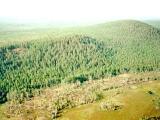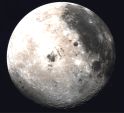|
Meteors -- what are
they? |
Most
meteors are streaks of light that appears in
the sky for a fraction of a second. They are caused when a meteoroid
-- a particle that usually ranges in size from a grain of sand to a
pebble-- enters the atmosphere of the earth from outer space.  The largest known meteoroid was the Chicxulub meteor in Mexico. It
is believed to have killed all the dinosaurs.
The largest known meteoroid was the Chicxulub meteor in Mexico. It
is believed to have killed all the dinosaurs.
In the
picture we show a drawing of what it looked like. The basin it
formed in Mexico's Yucatan peninsula has a diameter of 190 miles (300
kilometers). Rock samples obtained by drilling into the basin show
increased amounts of iridium, which indicates that an asteroid
struck the earth there. The impact hurled much debris into the sky.
Many scientists believe these particles were carried high into the
ionosphere, blanketing the earth for years, causing something similar to a
nuclear winter blocking out the sun and causing climate changes that the
dinosaurs could not survive.
Most meteors
vaporize when they enter the earth's atmosphere. The combined speed from
the meteoroid plus the earth speed may reach about 45 miles per second --
this is what causes the friction that melts the meteorite. Friction
heats up the meteoroid which gives off a trail of inflamed gases, and this
is what is seen by the naked eye as a bright path that some people call a
shooting star. In some meteors, the trail of gases lasts for a minute or
more.
 In
the last century a meteor vaporized before hitting the earth in Tunguska,
Russia. The area of devastation is still seen today, almost a
century after the episode occurred. In
the last century a meteor vaporized before hitting the earth in Tunguska,
Russia. The area of devastation is still seen today, almost a
century after the episode occurred.
If the mass of
the meteoroid is large enough, and it enters at the correct angle, it
could reach the surface of the earth; these are called meteorites.
The size of
meteorites varies. Most are relatively small, but a few have left a crater
when they hit the earth.
Thousands of
small meteorites have been found in Antarctica, because in Antarctica
there is no vegetation that would hide the remains of the meteorite and of
the impact it made on the earth surface. These meteorites have
provided a rich supply of specimens for scientists to study.
When a large meteor such as an asteroid crashes into a planet, it produces
an impact crater or basin. These basins are bowl-shaped
depressions. They have shallow, flat floors and uplifted rims. These
craters are found in other planets and satellites such as the moon.
|

Meteor
Crater in Arizona
|
|
Scientists have
found more than 100 impact craters on the surface of the earth. One of the
most famous, the Barringer Crater, also called Meteor Crater, in
northern Arizona is about 4,180 feet across and 570 feet deep. It was
formed when a large 90 to160 feet diameter nickel-iron asteroid struck the
Colorado Plateau in Arizona, USA. The enormous explosion excavated 175
million tons of rock and left a raised rim of smashed and
jumbled boulders, some of them the size of houses. It is still
visible because it is located in a desert area, where no vegetation hides
it from sight.
When Europeans
first encountered Meteor Crater, the arid sandstone plain around it
was littered with big boulders of meteoritic iron - over 30 tons of
it, scattered over an area 8 to 10 miles in diameter.
Most basins
and impact craters bigger than the Meteor Crater are largely eroded or
have been buried by rocks, dirt and vegetation due to the fact that they
are located in areas of heavy rainfall.
Meteoroids travel
around the sun in a variety of orbits and at different velocities.
The earth meets several streams of meteoroids every year. These
streams of meteoroids have orbits similar to those of comets, and are
believed to be the remains of disintegrated comets. These
streams of meteoroids entering the earth are called meteor showers.
|
|
|
The Leonids -- is
this a sign? |
 One
of the most brilliant meteor shower is the Leonid shower, given this name
because it seems to come from the direction of the constellation Leo.
It occurs every November. One of the most brilliant Leonid
showers was seen in 1833. The last Leonid shower was this year on
November 17-19. It was visible from several continents as the Earth
went through the path of several streams of the remains of comet Tempel-Tuttle
. One
of the most brilliant meteor shower is the Leonid shower, given this name
because it seems to come from the direction of the constellation Leo.
It occurs every November. One of the most brilliant Leonid
showers was seen in 1833. The last Leonid shower was this year on
November 17-19. It was visible from several continents as the Earth
went through the path of several streams of the remains of comet Tempel-Tuttle
.
Observers
counted about 4000 meteors per hour over the Americas, Asia and Australia.  They
also saw meteors strike the surface of the Moon. Brian Cudnik from
Houston, Texas, observing through a telescope, saw a brief flash, about a
fraction of a second, near the center of the Moon's dark side. The
event was also seen by astronomer David Dunham, who made a video recording
of the meteor striking the lunar surface. They
also saw meteors strike the surface of the Moon. Brian Cudnik from
Houston, Texas, observing through a telescope, saw a brief flash, about a
fraction of a second, near the center of the Moon's dark side. The
event was also seen by astronomer David Dunham, who made a video recording
of the meteor striking the lunar surface.
The moon surface is pockmarked with thousands of craters due to the fact
that the moon has no atmosphere and more space debris is capable of
reaching its surface.
Another probable lunar meteor impact was recorded by Gervase of
Canterbury in 1178. Along with five other monks, he observed a very
bright flash on the Moon:
"There was a bright New Moon, and as usual in that phase its horns
were tilted towards the east. Suddenly, the upper horn split in two. From
the midpoint of the division, a flaming torch sprang up, spewing out fire,
hot coals and sparks."
Some astronomers believe that the "moon is ringing like a bell"
since the time of this impact. Crater Bruno, one of the youngest on
the lunar surface, may have been formed in this event.
Does the bible say anything about these events or future events such as
this?
Revelation
6:12
I looked when He broke the sixth seal, and there was a great
earthquake; and the sun became black as sackcloth made of hair, and the
whole moon became like blood;
Revelation 6:13
and the stars of the sky fell to the earth, as a fig tree casts its
unripe figs when shaken by a great wind.
This describes a meteor shower. Observers of the last Leonid shower
were able to perceive that for a few minutes there were no falling stars.
Then suddenly three or more would "fall" at one time, similar to
a fig tree dropping unripe figs when shaken by a gust of wind.
The Book of
Revelation continues with the next event:
Revelation
6:14
The sky was split apart like a scroll when it is rolled up, and
every mountain and island were moved out of their places.
A mention of the sky being split apart occurred in 1908 at Tunguska,
Siberia.
According to an
eyewitness in Vanavara, "The
sky split apart and a great fire appeared. It became so hot that
one couldn't stand it. There was a deafening explosion [and my friend] S.
Semenov was blown over the ground across a distance of three sazhens [six
meters]. As the hot wind passed by, the ground and the huts trembled. Sod
was shaken loose from our ceilings and glass was splintered out of the
window frames."
The reason that
the sky split apart in Tunguska was that the heat of the meteor
caused the hot air to rise pushing away the clouds like a knife cutting
the sky. A similar event, but of a much larger magnitude will happen
in the near future, as predicted in the Book of Revelation.
We should be looking attentively to these signs of His coming.
Luke 21:28
But when these things begin to take place, straighten up and lift up
your heads, because your redemption is drawing near.
|
 The largest known meteoroid was the Chicxulub meteor in Mexico. It
is believed to have killed all the dinosaurs.
The largest known meteoroid was the Chicxulub meteor in Mexico. It
is believed to have killed all the dinosaurs. In
the last century a meteor vaporized before hitting the earth in Tunguska,
Russia. The area of devastation is still seen today, almost a
century after the episode occurred.
In
the last century a meteor vaporized before hitting the earth in Tunguska,
Russia. The area of devastation is still seen today, almost a
century after the episode occurred.
 One
of the most brilliant meteor shower is the Leonid shower, given this name
because it seems to come from the direction of the constellation Leo.
It occurs every November. One of the most brilliant Leonid
showers was seen in 1833. The last Leonid shower was this year on
November 17-19. It was visible from several continents as the Earth
went through the path of several streams of the remains of comet
One
of the most brilliant meteor shower is the Leonid shower, given this name
because it seems to come from the direction of the constellation Leo.
It occurs every November. One of the most brilliant Leonid
showers was seen in 1833. The last Leonid shower was this year on
November 17-19. It was visible from several continents as the Earth
went through the path of several streams of the remains of comet  They
also saw meteors strike the surface of the Moon. Brian Cudnik from
Houston, Texas, observing through a telescope, saw a brief flash, about a
fraction of a second, near the center of the Moon's dark side. The
event was also seen by astronomer David Dunham, who made a video recording
of the meteor striking the lunar surface.
They
also saw meteors strike the surface of the Moon. Brian Cudnik from
Houston, Texas, observing through a telescope, saw a brief flash, about a
fraction of a second, near the center of the Moon's dark side. The
event was also seen by astronomer David Dunham, who made a video recording
of the meteor striking the lunar surface.